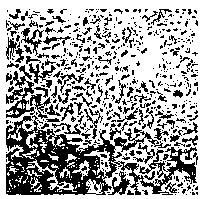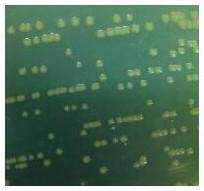Burkholderia cepacia P10 and application thereof
A Burkholderia and onion technology, applied in the field of agricultural microbes, can solve the problems that Burkholderia strains have no peanut growth-promoting effect, and achieve plant height increase, growth promotion, and great potential Effect
- Summary
- Abstract
- Description
- Claims
- Application Information
AI Technical Summary
Problems solved by technology
Method used
Image
Examples
Embodiment 1
[0023] Example 1: Isolation and identification of Burkholderia cepacia P10
[0024] 1.1 Isolation of Burkholderia cepacia P10
[0025] Collect 10g of tea tree rhizosphere soil from the tea garden in Kuanshui Nature Reserve, Guizhou Province, and add it to 90mL NBRIP liquid medium for enrichment culture; The culture medium was transferred to a fresh medium with the same composition, and cultured under the same conditions. This process was repeated 4 times; 1 mL of the last culture medium was drawn and diluted, and spread on NBRIP solid medium for 7 days at a constant temperature of 30°C. The colonies with larger phosphorus-dissolving hydrolysis circles were picked and streaked and purified repeatedly on NBRIP plates until pure cultured strains were obtained, which were labeled as P10.
[0026] The medium formula of the above NBRIP is: glucose 10g, tricalcium phosphate 5g, MgCl 2 ·6H 2 O5g, MgSO 4 ·7H 2 O0.25g, KCl 0.2g, (NH 4 ) 2 SO 4 0.1g, distilled water 1000mL, pH7.0...
Embodiment 2
[0039] Embodiment 2: Determination of growth-promoting properties of Burkholderia cepacia (Burkholderia cepacia) P10
[0040] 2.1 Determination of Phosphorus Solubilizing Ability of Burkholderia cepacia P10
[0041] Qualitative determination of phosphate dissolution: Spot the activated P10 strain on NBRIP solid medium, and culture it upside down at 30°C for 7 days, see attached image 3, Determining the diameter of the colony and the diameter of the phosphorus-dissolving hydrolysis circle, and calculating the ratio of the diameter of the phosphorus-dissolving hydrolysis circle / the diameter of the colony to be 3.29.
[0042] Quantitative determination of phosphate dissolution: Transfer the activated P10 bacteria solution to 100mL NBRIP liquid medium, culture it on a shaking table at 30°C for 7 days, take the culture solution and centrifuge at 10,000rpm at 4°C for 10min to measure the pH value, and use molybdenum blue colorimetry The soluble phosphorus content in the supernatan...
Embodiment 3
[0056] Embodiment 3: Burkholderia cepacia P10 is to the growth-promoting determination of peanut
[0057] Preparation of P10 inoculum solution: Inoculate the P10 strain into NA liquid medium at 30°C and shake at 150rpm for 24 hours, collect the bacteria by centrifugation and resuspend them with an appropriate amount of sterile water, adjust the OD600 value to 0.5 (the number of bacteria is about 10 8 cfu / mL) for use.
[0058] The formula of the above NA medium is: beef extract 5g, peptone 10g, sodium chloride 5g, distilled water 1000mL, pH7.0-7.2, sterilized at 121°C for 20min.
[0059] Soak peanut seeds in 20% hydrogen peroxide solution for 20 minutes for surface disinfection, rinse with sterile water several times, put them on sterilized filter paper moistened with distilled water, and germinate them in a constant temperature incubator at 30°C for about 3-4 days. Peanut seedlings were transplanted into seedling pots. Two treatments were set up in the experiment, the P10 st...
PUM
 Login to View More
Login to View More Abstract
Description
Claims
Application Information
 Login to View More
Login to View More - R&D
- Intellectual Property
- Life Sciences
- Materials
- Tech Scout
- Unparalleled Data Quality
- Higher Quality Content
- 60% Fewer Hallucinations
Browse by: Latest US Patents, China's latest patents, Technical Efficacy Thesaurus, Application Domain, Technology Topic, Popular Technical Reports.
© 2025 PatSnap. All rights reserved.Legal|Privacy policy|Modern Slavery Act Transparency Statement|Sitemap|About US| Contact US: help@patsnap.com



